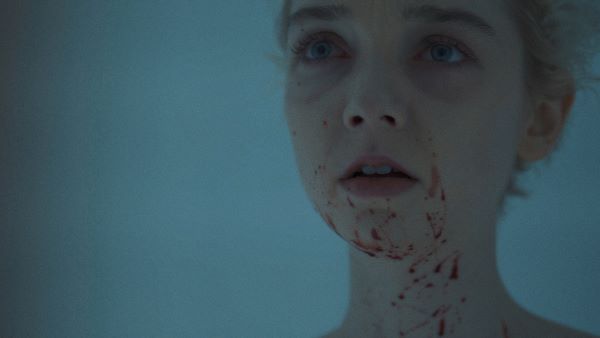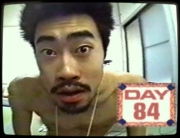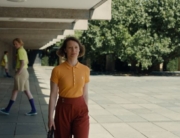
Sarah Dunn (Julia Sarah Stone) has something of a sleeping problem, among other issues. She’s a teenage runaway, still attending school, occasionally crashing at a friend’s place, and only revisiting her own home to steal things that help make living in a nearby park manageable. For the most part, Sarah’s on her own, often spending her days drifting aimlessly through town on her bike and falling asleep in class. When she sleeps, though, what she dreams is beyond surreal: dolly shots of an endless black-and-white labyrinthian realm, all leading to some mysterious humanoid shadow in the distance.
Then, partially on a whim and because it offers her a place to stay, Sarah decides to sign up for a paid sleep study program. As explained by one of the study doctors, she and other subjects will have their brainwaves recorded while they rest overnight, the results of which will be uploaded to a machine that processes their dreams into physical images. It all appears relatively harmless at first. However, if the film’s ominous mood weren’t reason enough to warrant suspicion, Sarah learns that something’s amiss after her body reacts badly to seeing the ultrasound-like brainwave scans that reveal something sinister within her mind.
From the start, Come True gives off a sense of cerebral horror beyond its desaturated, almost melancholic depiction of Sarah’s everyday life. Written and directed by Anthony Scott Burns (Our House), it invokes a type of Lovecraftian existentialism between the dreamscape and this mysterious “shadow with eyes” Sarah keeps seeing. Depicted almost like an embodiment of nightmares, it’s a figure that the project’s overseer wishes to study closely and another scientist named Jeremy (Landon Liboiron), who has a thing for Sarah, recognizes from his childhood nightmares. The more Sarah interacts with the tests, the greater the shadow’s presence becomes, eventually blurring lines between dreams and reality.
Burns’s strongest talent lies in creating atmosphere. Stylistically, Sarah’s life feels like an endless cycle of repetition (go to class, ride bike, try to sleep in the park) with no sense of purpose. It’s not so much bleak as it is passive, the kind of lifestyle one can’t seem to escape. Yet one look into her dreamscape makes that world appear far more pleasant by comparison. Every sequence is the same yet completely different: a camera shot that ventures inward through dark corridors, desolate wastelands, and gothic castle structures. No explanation is given for the symbolism behind these hallways and Twilight Zone-inspired doors, save for the reoccurring presence of the Shadow Man inside all of them. A lot of thought went into this minimalist Lynchian imagery–the Shadow Man becomes more vivid and detailed with each new dream–and as a means of getting under one’s skin, it certainly pays off.
Personality-wise, these aren’t the deepest of characters, though Stone’s performance succeeds at making you want to see Sarah escape this predicament unharmed. However, they still come across as smart in terms of decision-making, which is also a rarity for the horror genre. Sarah doesn’t blindly follow others, and while their scientific motivations are dangerous, the researchers are never irrational when trying to observe the entity’s power. This sincerity helps elevate the tension as the ensemble tries to figure out what is going on, all without the action ever devolving into a mess of exaggerated gore and jump scares.
The only place where the movie goes off the rails is, unfortunately, during its final minutes, rejecting the semi-grounded scientific elements for a more psychological twist. While this twist tries to build upon a number of briefly glimpsed dream imagery recorded on Jeremy’s equipment, it comes practically out of nowhere, mainly there to raise even more questions about the dreamscape’s connection to Sarah’s psyche. It’s the kind of reveal that viewers will almost certainly try to deconstruct, but I found this outcome the most notably “gotcha” moment of a film whose horror was strongest in its subtly.
Still, much like A Nightmare on Elm Street or Inception, Come True taps into deep-seated Freudian fears of what drives the human mind. Thanks to Burns’s haunting visual direction, it will certainly keep viewers anxious when they close their eyes after watching the film. Sweet dreams!






Leave A Comment